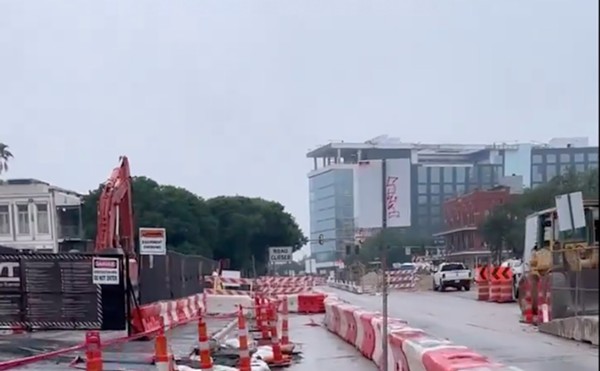Greg Harman
Ten billion or $22 billion? What does it matter how much it costs to build two new nuclear power plants in Matagorda County if a hijacked airliner comes crashing down into the equation?
Better yet, where do the billions go if South Texas Project's best can't pull enough water from the Guadalupe River to cool their reactors?
And just why hasn't anyone plugged the leak on the bottom of the existing nuclear power complex's 7,000-acre cooling reservoir?
These are the sorts of questions anti-nuclear activists will be asking of the U.S. Nuclear Regulatory Commission when it convenes for two days of open meetings in Bay City next week.
A similar summer gathering was hosted by the NRC's Atomic Safety and Licensing Board concerning the proposed expansion of the Comanche Peak nuke plant recently up in North Texas, but activists see the application by San Antonio-owned CPS Energy and partner NRG Energy as even more vulnerable to critique.
“This application is much more incomplete,” Karen Hadden of the SEED Coalition said, adding that opponents have objected to the STP license on 28 points compared to the 18 raised over Comanche Peak.
As San Antonio entered State Two drought restrictions and Valley growers are witnessing a sun-savaged year of crop losses from extended drought, it would make sense to explore the consumption of water resources (and pollution thereof) the proposed plants represent.
Lauren Ross of Glenn Rose Engineering attempted to do that, but found many of her questions unaddressed in the license application.
 “We can see over the â?¦ time the plant has been operating that those tritium ground water levels are increasing,” Ross said, “but their permit application makes no effort to estimate what the consequences are of doubling the production capacity. Clearly we would expect those tritium levels would increase.”
“We can see over the â?¦ time the plant has been operating that those tritium ground water levels are increasing,” Ross said, “but their permit application makes no effort to estimate what the consequences are of doubling the production capacity. Clearly we would expect those tritium levels would increase.”
The existing plants have already contributed to elevated tritium levels in area water, Ross said.
Just as the application is silent on expected increases in radioactivity released to ground and surface water, it is also “absolutely silent on the saltiness of the water that would be discharged from their cooling reservoir,” she added.
In fact, operators at STP “haven't discharged any water from the main cooling reservoir since the 1990s,” Ross said.
That's because it's leaking out of the bottom of the reservoir, apparently outside the legal purview of state regulators.
From the report:
"Water from the MCR is also released through the pressure relief wells located in the above-grade dike surrounding the MCR. Water from these relief wells is discharged to a surface water ditch that surrounds the MCR and flows away from the reservoir through the STP site's natural drainage features.”
Given that all other permitted plant outfalls flow into the MCR and that there has been no MCR discharge through Outfall 001 since March 1997, this leaked water through the bottom of the MCR has been the single significant wastewater discharge for the entire facility for more than 12 years.
Water in some of the relief wells demonstrates concentrations of radioactive tritium and potentially conveys any of the wastewater characteristics that would be regulated were the discharge to occur through Outfall 001.
There are a lot of other issues with the permit (28 in all, including unregulated wastewater discharge) that members of SEED, Public Citizen, and South Texas Association for Responsible Energy will be raising at the meeting June 23 and 24.
Other concerns include inadequate fire protection, lack of viable radioactive waste disposal plan, and an inability to secure against airplane attacks.
Hadden also suggested the potential impact of the plant's radioactive emissions on nearby nesting whooping cranes should be studied considering he ongoing drought that has severely impacted the endangered bird.
“We are not claiming the whooping cranes have already been impacted by radiation, but we do think that it's time to examine whether there is an impact,” Hadden said. “They next 35 miles from the site and they've had their worst winter ever â?¦ It's a good time to make sure there's not additional impact from radiation.”
You can read the full water report below.
Water Quality and Quantity Impacts from Proposed South Texas Plant Expansion


















